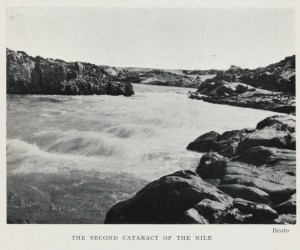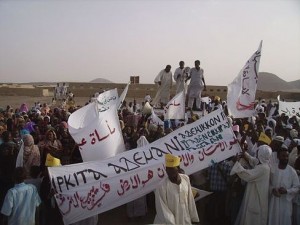The Nubian communities along the Nile in northern Sudan, which were mostly spared from flooding by Lake Nasser in the 1960s, are now facing the threat of destruction by dams in their own valleys. Three huge new dams have been proposed for construction across the Nile, threatening tens of thousands of people who thrive on their riverside farming and fishing. The dams were proposed many years ago but the government of Sudan has been unable to build them due to a lack of financing. Until, that is, decisions were reached in early November.

The Dal Dam, located at the Second Cataract of the Nile, would generate about 340 – 450 megawatts of power and would displace over 5,000 Nubians, while the Kajbar Dam, at the Third Cataract, would generate 360 megawatts of electricity and would displace around 10,000 Nubian people.
The dams became a serious threat on November 3 when Sudanese President Omar Al Bashir and his assistants flew to Riyadh to meet with Salman Bin Abdulaziz, the King of Saudi Arabia. Officials signed a deal, part of which provided Saudi funds for the construction of the two dams in the Nubian homeland, plus a third farther up the river nearer Khartoum.
The two dams, if built, would have the same effect on the Nubians along this stretch of the Nile as the Aswan High Dam had on the people of southern Egypt. They will be displaced from their villages and forced to live in resettlement communities far from the riverine environment that has fostered the peacefulness of their villages. Needless to say, they are reacting vociferously to the news.
In a statement issued on November 8, the Association of Nubians announced that its members completely reject the construction of the Dal and the Kajbar Dams. The group called for a massive campaign against their construction. It also asked the government of Saudi Arabia “not to get involved in the financing of this project which is benefiting the regime in Khartoum at the expense of the Nubian culture and territory.”
The government of Sudan has already indicated how it will react to protests against the dams. Peaceful protests in 2007 against the proposed Kajbar Dam resulted in security forces killing four people and injuring over 20. Activists protesting the dams in more recent years have been detained by security forces. Nubians, for their part, warn that a situation comparable to the rebellion in Sudan’s Darfur region could result if construction of the dams begins.

An analysis published by the respected Jane’s Information Group concurs. It suggests that there will be an increase in the risks of civil unrest if the projects proceed. Initially, small groups of less than 500 Nubians will protest by blocking highways leading to the Dal and the Kajbar dam sites, with less chance of protests at the dam farther south.
But the leader of the Nubian Youth Committee against the Kajbar and Dal Dams, Rashed Sheikh Eldin Abash, was taken into custody on September 23 by the Nubian National Intelligence and Security Services (NISS). If he is prosecuted by the government, Jane’s warns, the situation could escalate into violent protests. The NISS would then likely escalate also and start using live ammunition in response.
The Nubians continued to seethe as the month wore on. The Popular Committee against the Kajbar Dam accused the government of wanting to exterminate the Nubian people. Residents of El Birgeeg, in the Northern State, warned that the region would turn into another Darfur if the government proceeded. Ezzeldin Idris Mohamed, the chair of that group, told the press that the Nubians would completely reject the construction of the two dams, even if they were handed the presidential palace as compensation.
In a meeting, members of the committee all vowed to remain on their lands even to the death, the chairman reported. The people in El Birgeeg described plans for the construction of the dams as a declaration of war on the Nubian people of Sudan’s northern region. Another group indicated that they are determined to protect their land and will resist the government, using all possible means.
International Rivers, a U.S.-based non-profit, non-governmental organization, which for years has advocated for the Nile to remain free of dams, joined the current chorus of protests with a report on November 19. It quoted a member of the Nubian Association as saying, “We will never allow any force on the earth to blur our identity and destroy our heritage and nation. Nubians will never play the role of victims, and will never sacrifice for the second time to repeat the tragedy of the Aswan Dam.” The Nubian communities have signed a petition opposing the two dams.
Of course, not all the comments from outside the government have opposed the dams. Alsir Sidahmed wrote, in a statement published last week, that environmental issues should also be part of the decision-making process. Decision makers need to strike a balance, he argued, between preserving the environment and improving the living conditions of the Sudanese people. But “since the ultimate goal is the well-being of the people, they should be consulted and engaged,” he suggested. It was not clear if he was thinking of the well-being of the Nubians or of the Sudanese people more broadly.